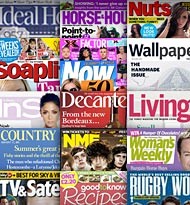It’s been a hell of a year at Time Inc. First, came the lay-off of 6% (500) of its employees. Then, there was the abortive “merger” with Meredith, publisher of Better Homes & Gardens, Family Circle and Ladies Home Journal. It became clear that the talks to offload Time Inc magazines into a Meredith-managed joint venture had been initiated by Time Warner chairman Jeff Bewkes. He notionally valued Time Inc at up to $2bn but was prepared to ease the path considerably by
accepting payment in shares instead of cash.
The plan seemed to ignore the obvious cultural differences between New York-based Time, and Meredith from Des Moines, Iowa. Time had built its reputation as a weekly magazine specialist while Meredith had largely stayed close to women’s monthly “service” magazines. In the event, few were surprised at the failure of the talks, which finally foundered on Meredith’s insistence on not taking over the key non-women’s magazines – Time, Fortune, Sports Illustrated and Money – the brands for which Time Inc is best known.
The fiasco left staff reeling. One said: “Morale is terrible. There’s a lot of anger at Bewkes over the way he mishandled Time Inc.” It sparked premature obituaries for the company, named after what was once the world’s most influential magazine. Its founders had virtually invented the modern news weekly and went on to become publishers of some of the most popular titles in the US. But, now, it had all changed. The magic had gone, and shocked staff talked of “grotesque amounts of empty space” on floors of the landmark Time-Life building in New York’s Rockefeller Plaza.

But Bewkes was responsible for building up the company’s prized HBO cable TV business, and is nothing if not gutsy. In 2002, two years after Time Warner’s disastrous merger with AOL, he had interrupted Steve Case, then chairman of AOL Time Warner, in an internal meeting, to describe the seemingly spectacular deal as “Bullshit…the only problem with this company is AOL.” Seven years later, he had the task of dismantling what he described as “the biggest mistake in corporate history.”
So, Bewkes was not going to lose any sleep over the hassle of failed talks with Meredith in March. His speedy riposte was to announce that Time Inc would be floated off on the stock exchange in 2013 – and with a new CEO to replace Laura Lang after just 15 months, which was 10 months longer than her predecessor: “A complete spinoff of Time Inc provides strategic clarity for Time Warner, enabling us to focus entirely on our television networks and film and TV production businesses, and improves our growth profile.”
Established companies spend months and years plotting IPOs, ensuring they have proven executive teams, robust strategies and credible promises of long-term profit growth. They tend not to look as though they are in a hurry to sell. And few go to market while privately admitting they are still over-staffed. But Bewkes was having none of it. By July, he finally appointed former Time Warner and AOL chief financial officer Joe Ripp as the third CEO of Time Inc in under two years.
He reluctantly conceded the IPO would have to be delayed, although only until early in 2014. But advisers kept pushing back. Earlier this month, with the CEO scarcely two months into his job and after issuing another sliding set of financials, Bewkes delayed the IPO a few more months, probably to June 2014, saying that the new team “have been in place for a couple months now and they are making great progress in preparing Time Inc. to become an independent publicly traded company. We have decided that it is prudent to give Joe some time to further refine Time Inc’s strategic direction.”
Would-be investors need not worry about whether Time Inc has been ramped up for sale. It hasn’t. The company still throws off a lot of cash but its profitability seems to be in permanent decline – and that’s before you take account of the need to make up for lost time by stepping up investment in digital where once it had been a pioneer. For Time Warner, it’s all too hard. You have to conclude that the parent company is prepared to heavily discount the price of its legendary 91-year-old magazine business rather than have to worry for a moment longer about this catalogue of its problems:
- Financial decline: Few non-trade investors anywhere are investing in magazines. While there are clear signs of slowing in the decline of circulation and advertising revenues, there are not many predictions of medium-term growth, normally the least that would-be investors expect. Time Warner’s recent financials were transparent. The strong performance of its film and TV businesses was dragged down by Time Inc where advertising and subscriptions revenue were down by 5% and 7% respectively following a similar pattern to last year when EBITDA profit had been 25% down on 2011. In the UK, where IPC Media accounts for some 15% of Time Inc total revenues, profits were down 24% to £28.2m – a fall of two-thirds in six years.
-

People: Time Inc’s (and America’s) most profitable magazine: 20% of all revenue Leadership upheaval: Veteran Joe Ripp’s appointment followed Time Warner’s public failure to recruit a succession of ‘hot’ candidates. Some commentators noted he was was an executive who last worked at Time Inc. nearly 10 years ago, when the company was enjoying a streak of 11 straight years of revenue growth. Perhaps it will be the same story in London where the company has had similar problems replacing Sylvia Auton, the longtime CEO of IPC Media whose job has been vacant since she left in April. Not a good look for the IPO, even though the newly-appointed CEO – DMGT and EMAP high-flier Marcus Rich – will be in place (just) by Spring 2014.
- Culture clash: Magazine companies everywhere are awash with discussion of native advertising. For many, this online blurring of the distinction between editorial and advertising is fundamental to the viability of digital media. Time Inc’s trouble is that the company’s major weekly magazines almost invented the traditional separation of “church and state”. And countless current and former executives bear the scars of challenging Time Inc conventions, including the then US-based Sylvia Auton who insisted on having editors reporting to her – only for it to be reversed when she returned to IPC in London. Joe Ripp’s seemingly ironic response to the need to change the culture has been to bring back 71-year-old Norman Pearlstine, who, in his former days as Time Inc editor-in-chief, had been its fiercest defender. Now, the highly respected Pearlstine is talking a good game about having editors reporting to the “business side”. But it all feels a bit strange and one blogger addressed Ripp directly about Pearlstine’s track record: “According to your memo… his charge will be to forge ‘a strong partnership between business and editorial’. Joe, are you not aware that Time Inc.’s legacy (and, till now, Pearlstine’s) has been to maintain an impervious firewall separating business and editorial so as not to corrupt the latter with the former?” Changing the culture – and the high costs and excess staffing that go with it – might involve plenty of in-fighting – and expense. Another reason why this most traditional of publishing companies needs more time than it is going to get.
-

Time Inc: slightly digital but still overwhelmingly magazines Mainly magazines: Despite their financial performance, Time Inc’s core magazines including Time, Fortune, Sports Illustrated, Money, Entertainment Weekly, InStyle, and People (the country’s most profitable, which accounted for no less than 20% of all Time Inc revenues in 2012) are the kind of trophy media assets that could attract the cash of digital natives. But some 55 of Time Inc’s 70 magazines are published in the UK, with an increasing number of them rendered unprofitable or marginal by falling revenues, high centralised costs, and historic pension commitments. The current level of UK performance means that a small handful of the IPC magazines would – under alternative ownership – account for almost 100% of the profit. But the break-up/ disposals to achieve that “true” profitability could be expensive and hugely disruptive. It probably means that Time Inc itself could actually be valued more highly – and have a clearer, more persuasive strategy – without IPC. (There’s a timely thought for private equity). But Time Warner has already spent too many years since it acquired IPC Media in 2001 trying to find ways of unlocking profit and/or disposing of parts or the whole company. The rate of profit decline now raises the prospect that an eventual disposal might need to involve a “dowry” to fund a purchaser’s plans for rationalisation and break-up. Doubts about the future ownership of IPC have made recruitment of a CEO there as difficult as it had done for Time Inc itself. Which, of course, adds to the uncertainty and to the likely drag on the IPO share price. That’s what Time Warner executives are hearing from all sides and the grudging delay in the IPO may have been partly driven by consideration of the prior divestment of IPC. This will be difficult to achieve anyway, let alone in the next few months. Hence the drive for a big new Time Inc strategy.
- Strategy gap: The disposal of Time Inc certainly risks being a corporate embarrassment – and producing proceeds that will dilute Time Warner earnings not enhance them. It’s not that the company cannot be sold or floated, with or without IPC. Anything can, of course, be sold at the “right” price. And for Time Inc, that may mean accepting a relatively low flotation price and without much (if any) debt transferred to the company. Advisers will be comparing their plans with those of Rupert Murdoch’s News Corp which was this year spun-off from 21st Century Fox debt-free and with cash deposits of $2.6bn. Nobody is contemplating such largesse from Time Warner. But the best chance of a successful flotation will be with some kind of transformational acquisition pointing the way to the company’s future development in digital media; and there is increasing speculation that such a deal is being pursued. But any worthwhile ‘digital dowry’ could be very pricey.
In any other context, Time Warner might have decided that it needed more time to sort out Time Inc, find a new home for its publishing assets – and get a fair price. But the events of 2013 show that Jeff Bewkes is a man in a hurry.
That was obvious enough in the way the Meredith deal failed, because so little had been agreed in advance of formal negotiations. The Time Warner chairman was just too quick to grasp at the half-possible opportunity. But Bewkes, has never pretended to be anything other than sceptical about magazines. Back in 2006, on his appointment as CEO of Time Warner, he visited IPC Media in London. He wasn’t trying too hard to motivate his executives and made clear his disinterest in their proposed digital investments, compared with TV and film. Insiders would bet he had already decided, even then, to get out of print.
You can, therefore, imagine what was going through Bewkes’ mind as he opened the talks with Meredith, knowing that the 2012 profits of his UK magazines company had fallen to just £28m. The 44% collapse to less than £200k in the 2012 profits of IPC’s UK edition of Marie Claire also seemed to symbolise the way that the newsstand-dependent UK magazine market had suffered even more than the subscriptions-based US.
The fact is that the five leading British publishers (Bauer, IPC, Hearst, Immediate, and Conde Nast) are together earning the pre-tax profits generated by IPC alone just a decade ago. And it is notable that the company which for most of 50 years was the UK’s largest magazine publisher (by far) could only be described in the Time Inc spinoff filing as the “largest by newsstand revenues”. Today, both Hearst and Bauer may be larger in the UK by total revenues.
The Time Inc developments inevitably cast a long shadow over IPC, formed in 1963 by the merger of three competing companies – Odhams, Newnes, and Fleetway – which in 1968 had added the Daily Mirror newspapers. It became the publisher of more than 100 magazines, including the country’s four major women’s weeklies together selling some 8million copies, and publications across almost every sector.
In the 1980s, competitive magazines started to come thick and fast, through the expansion of then regional publisher EMAP, BBC launches of TV-linked magazines, the arrival of German publishers Gruner & Jahr and Bauer, and the expansion of US-owned Hearst and Conde Nast. It became easy to lampoon IPC as the “ministry of magazines” in a tower block – bigger, richer and maybe slower moving than its newer, smaller, more agile competitors. But it was IPC which gave British readers Loaded, Look, Now, Look & Learn, the imported Marie Claire and In Style, and the market’s steadiest presence Country Life.

IPC was milked for profits, first by the Reed International conglomerate (as it shifted focus from consumer to business and professional media) and then by Cinven private equity which bought the company in 1998 for £860m and sold it to Time Warner three years later for £1.15bn. Things never felt so good again. But many of the IPC niche brands seemed to fit well with their US counterparts. But that was a measure of how Time Inc had changed after 60 years of publishing primarily its major weeklies.
It had been the largest magazine publisher in the US, flying high above the hyper-competitive and fragmenting markets for women’s and specialist magazines. And, then, in 1995, it paid a publishing record $498million for Alabama-based Southern Progress, which brought magazines like Southern Living, Coastal Living, and This Old House. That entry into the ‘new’ world of niche magazines led directly to the acquisition of IPC six years later – and, now, to the spin-off of the whole lot for a fractional price.
The Time Inc weeklies had seemed to offer synergies with the parent company’s cable TV businesses, but niche special interest and women’s ‘service’ magazines in the US, Mexico and the UK were always a stretch. However, the man who promoted the IPC acquisition was one-time Time Inc chairman Don Logan, who had joined the company as CEO of Southern Progress. So his strategy was to publish lots of magazines all over the world. And Logan made IPC’s executives feel right at home: “This is the perfect acquisition for AOL Time Warner because it accomplishes key strategic goals for the company. With some of the best-known consumer publishing brands in Europe, IPC provides Time Inc with an important presence within the European consumer publishing sector. This acquisition also furthers AOL Time Warner’s goal of expanding our operations outside of the US.”
Logan retired in 2005. Within five years, AOL had gone too. And Time Inc itself had started to feel isolated, let alone its UK subsidiary.

IPC Media did, though, enjoy a glorious honeymoon, marked by a move into its Blue Fin landmark building on the south bank of Thames. Rising property values made that a financial coup – the high watermark of the company’s overall performance. But, soon after settling into their fine new offices, executives were hearing sell-off rumours, amid indications that Time Warner (by now, expensively shorn of AOL and the executives who bought or came with it) would be ‘refocused’ on TV, film and cable.
Today, IPC Media is:
- 55 magazines read by almost two-thirds of all UK women and more than one-third of all men
- Web sites used by 25 million global users each month
- £300m turnover
But the numbers are not the real story. True, IPC continues to publish many of the UK’s strongest (and oldest) magazine brands. But profits have been decimated as the steam has gone from once high-growth sectors like celebrity weeklies, and men’s magazines – and from hard copy advertising. Time Warner’s response has been to reject investment and push for cost savings and price increases in a bid to hold profits – and hope for an exit. In January this year, IPC laid-off 8% of its staff.
It has been bad enough for the core Time Inc magazines but worse still for IPC Media across the Atlantic, left to put on a brave face and try to give the impression of equipping itself for the digital future when it has so clearly been denied the funds to do so.

But look behind the headlines and you find that the UK group’s single most profitable magazine – the 1million-selling weekly What’s on TV – may effectively have accounted for 50% of total profits. IPC has a market-leading 40% of the TV listings sector which – against all digital odds – continues to sell almost 4million weekly copies and remains a rich seam of UK magazine profits – also for privately-owned Bauer and private equity-owned Immediate. Two of the country’s three most profitable consumer magazines are listings titles Radio Times (from Immediate) and IPC’s What’s on TV (the other is Vogue).
Would-be bidders might be interested in further comparison with the highly-profitable London-based H.Bauer operation that pre-existed the German company’s £1bn UK acquisition of the former EMAP’s consumer magazines and radio stations. The 27-year-old, still largely-separate business is located in an unfashionable corner of the city and publishes magazines including Bella (mid-age women’s weekly), Take a Break and That’s Life (real life and puzzles), and TV Choice (listings).
The 200 employees of that original Bauer UK business still generate some £20m of profit – almost the same as that made by the 1,700 people of the mighty IPC. The truth, of course, is that IPC’s own Bauer-like magazines would separately generate at least as much profit. But, then, IPC Media is less than the sum of its parts – which is the case for break-up.
Former CEO Sylvia Auton (who spent 36 years managing almost every part of this vintage business) once reflected on the way that a break-up could yield rich pickings – and is said to have suggested it to Jeff Bewkes. But now she’s retired, Time Warner is going, and Time Inc must come up with a “solution” for its UK subsidiary.
Apart from the shrunken women’s weeklies and the Marie Claire joint venture in the UK, IPC publishes iconic titles like Country Life, NME, Decanter, Horse & Hound, and Wallpaper, 50% of the steady and profitable home interest market, and 25% of fashion and lifestyle magazines. The monthly Woman & Home is the only one of IPC’s top 10 titles to have increased its circulation steadily in recent years; and subscribers account for 38% of its average 340,000 monthly sales, making it less vulnerable to newsstand cuts. Then there are potentially rich and dominant positions in boating, country sports, and cycling. You can find significant pockets of potential profit nearly everywhere – once freed of high overheads and pension liabilities.
All magazine-centric businesses must, of course, increasingly move from producing hard copy products to creating digital services and other activities. That means a wholesale change in the business model and, perhaps, a recognition that many publishers might not, after all, be able to hack ecommerce. That is becoming clear from the way that the digital natives (like Net a Porter and ASOS) are now acquiring traditional magazine skills; and it is just a matter of time before they move into online TV too. Even the strongest magazine brands may have difficulty competing with online retailers coming down the media road from the other direction.

But, for IPC, a break-up could help progressive operators turn many of the UK’s best magazine brands in a still substantial publishing market into strong digital – and hard copy – businesses. Prospective buyers have tired of trying to persuade Time Inc to cut their losses and sell the UK company in whole or parts. But it has taken Time Warner many years to accept that it may now not be able to recoup even a quarter of its £1bn purchase price from any sale.
Once Time Inc is a separate public company next year, the IPC question will be back on the agenda. But perhaps something will happen before then. After all, Ripp has his work cut out writing a growth strategy for Time Inc’s US weeklies. Will he really even want to try to persuade investors to back him across the Atlantic?
Could the CEO gap at IPC embolden would-be bidders? Or will it scare Time Inc into kick-starting the process towards slimming down its London-based company, selling off more magazines, and squeezing out profits- even before Marcus Rich arrives? The amiable Joe Ripp, who breezed through London recently to meet his executives, knows that IPC Media is another part of the Time Inc story that really needs to be re-written for the IPO prospectus. The clock is ticking.




